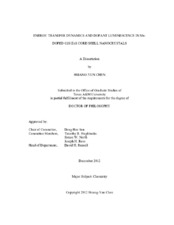| dc.description.abstract | Mn-doped II-VI semiconductor nanocrystals exhibit bright dopant photoluminescence that has potential usefulness for light emitting devices, temperature sensing, and biological imaging. The bright luminescence comes from the 4T1→6A1 transition of the Mn2+ d electrons after the exciton-dopant energy transfer, which reroutes the exciton relaxation through trapping processes. The driving force of the energy transfer is the strong exchange coupling between the exciton and Mn2+ due to the confinement of exciton in the nanocrystal. The exciton-Mn spatial overlap affecting the exchange coupling strength is an important parameter that varies the energy transfer rate and the quantum yield of Mn luminescence. In this dissertation, this correlation is studied in radial doping location-controlled Mn-doped CdS/ZnS nanocrystals. Energy transfer rate was found decreasing when increasing the doping radius in the nanocrystals at the same core size and shell thickness and when increasing the size of the nanocrystals at a fixed doping radius.
In addition to the exciton-Mn energy transfer discussed above, two consecutive exciton-Mn energy transfers can also occur if multiple excitons are generated before the relaxation of Mn (lifetime ~10^-4 - 10^-2 s). The consecutive exciton-Mn energy transfer can further excite the Mn2+ d electrons high in conduction band and results in the quenching of Mn luminescence. The highly excited electrons show higher photocatalytic efficiency than the electrons in undoped nanocrystals.
Finally, the effect of local lattice strain on the local vibrational frequency and local thermal expansion was observed via the temperature-dependent Mn luminescence spectral linewidth and peak position in Mn-doped CdS/ZnS nanocrystals. The local lattice strain on the Mn2+ ions is varied using the large core/shell lattice mismatch (~7%) that creates a gradient of lattice strain at various radial locations. When doping the Mn2+ closer to the core/shell interface, the stronger lattice strain softens the vibrational frequency coupled to the 4T1→6A1 transition of Mn2+ (Mn luminescence) by ~50%. In addition, the lattice strain also increases the anharmonicity, resulting in larger local thermal expansion observed from the nearly an order larger thermal shift of the Mn luminescence compared to the Mn-doped ZnS nanocrystals without the core/shell lattice mismatch. | en |


